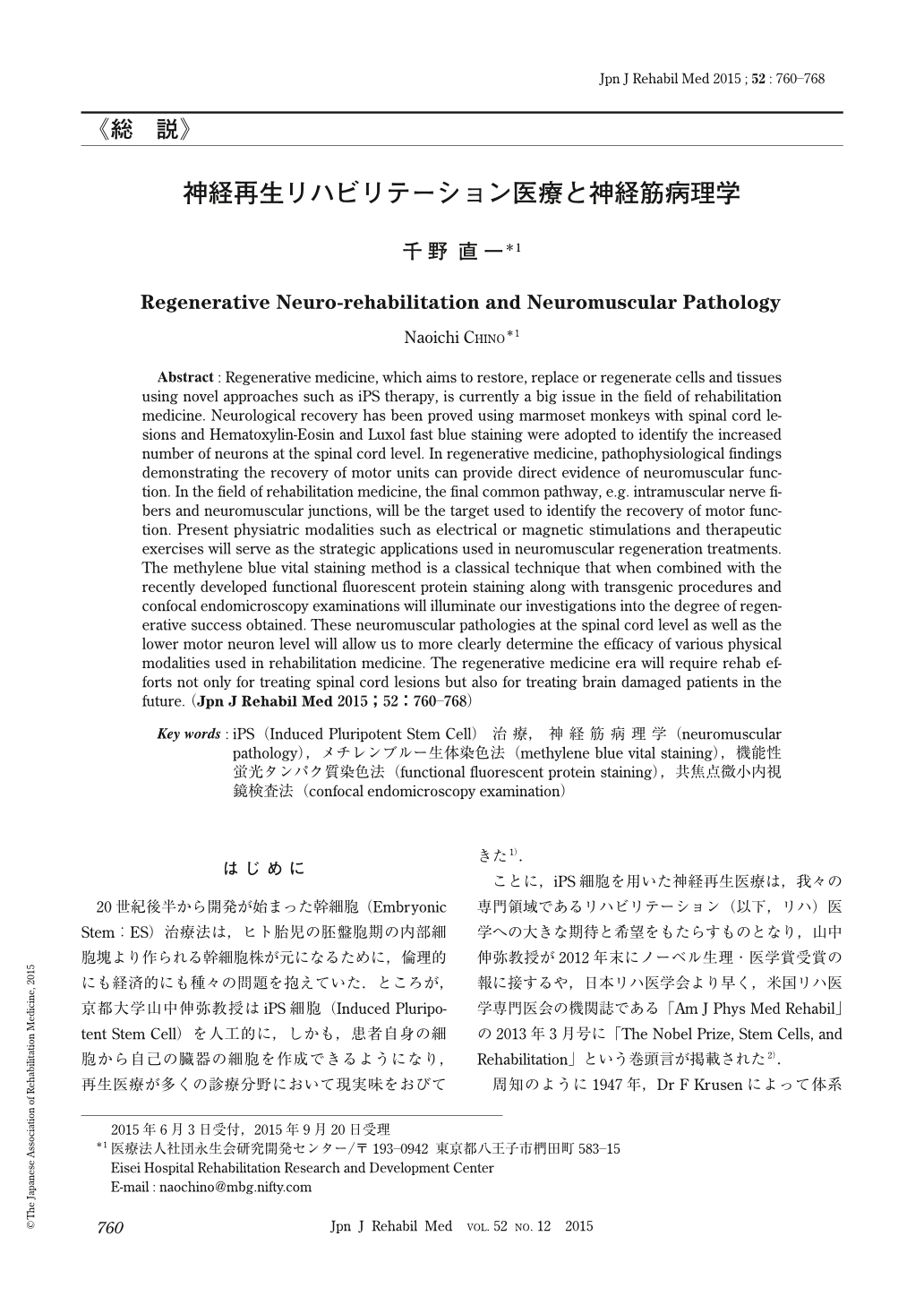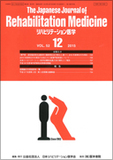Japanese
English
- 販売していません
- Abstract 文献概要
- 1ページ目 Look Inside
- 参考文献 Reference
はじめに
20世紀後半から開発が始まった幹細胞(Embryonic Stem:ES)治療法は,ヒト胎児の胚盤胞期の内部細胞塊より作られる幹細胞株が元になるために,倫理的にも経済的にも種々の問題を抱えていた.ところが,京都大学山中伸弥教授はiPS細胞(Induced Pluripotent Stem Cell)を人工的に,しかも,患者自身の細胞から自己の臓器の細胞を作成できるようになり,再生医療が多くの診療分野において現実味をおびてきた1).
ことに,iPS細胞を用いた神経再生医療は,我々の専門領域であるリハビリテーション(以下,リハ)医学への大きな期待と希望をもたらすものとなり,山中伸弥教授が2012年末にノーベル生理・医学賞受賞の報に接するや,日本リハ医学会より早く,米国リハ医学専門医会の機関誌である「Am J Phys Med Rehabil」の2013年3月号に「The Nobel Prize, Stem Cells, and Rehabilitation」という巻頭言が掲載された2).
周知のように1947年,Dr F Krusenによって体系作られた「リハビリテーション医学:Rehabilitation Medicine」は,専門医会創設時は「物理医学:Physical Medicine」という名称であったが,1949年に「リハビリテーション:Rehabilitation」が追加されて,現在の米国専門医制度の1つの分野として,「物理医学とリハビリテーション:Physical Medicine and Rehabilitation:PM&R」になっている.
リハ医学での診断と治療は「物理医学:Physical Medicine」が主体となることは言うまでもない.そして,神経筋骨格系の障害によって「動けなくなった症状:Dysmobility」の診断と治療,ならびに患者(児)の社会復帰を目的とする医学・医療の専門分野であったが,時代の変遷と相俟って,現在では「リハ医学」の守備範囲は神経筋骨格系から,呼吸循環器系,認知機能,摂食嚥下機能などに広がっている3).
具体的な説明を加えるなら,リハ医学の主体は,動けなくなった「随意運動障害の診断と治療」にあり,その病態検索や治療のターゲットは,大脳より脊髄に至る中枢神経から,運動単位(前角細胞,末梢神経,神経筋接合部,筋線維)の運動・感覚コントロール機構全体に関わる.そして,新しい“神経再生医療”の時代に,リハ医学の基礎として今までに培われてきた,運動単位を中心とする,神経筋病理学や筋電図・臨床神経生理学の応用が焦眉の急となっていることをリハ医学・医療関係者は改めて認識しなければならない.
現時点で,iPS細胞による再生医療の動物実験ターゲットは頸部脊髄レベルである4).その脊損高位においては脊髄前角細胞が損傷されることによる末梢神経障害に準ずるリハ治療法が施されるが,脊損部位より下位レベルでは中枢神経麻痺であり,リハ治療では痙縮などへの対応が必要となる.将来的に神経再生医療は,脊髄より中枢の,大脳,小脳など,所謂,脊髄上(supraspinal)神経経路へも実用化されることであろう.
そこで,本稿では脊髄から遠心性,求心性神経線維ならびに神経筋接合部,筋線維を中心に,従来からリハ医学で用いられた神経筋の病理学の検体検査法などと合わせて,染色法の歴史的変遷などを概説し,若手リハ科専門医がリハ医学の基礎研究手段の1つとして参考になるように解説する.
Abstract : Regenerative medicine, which aims to restore, replace or regenerate cells and tissues using novel approaches such as iPS therapy, is currently a big issue in the field of rehabilitation medicine. Neurological recovery has been proved using marmoset monkeys with spinal cord lesions and Hematoxylin-Eosin and Luxol fast blue staining were adopted to identify the increased number of neurons at the spinal cord level. In regenerative medicine, pathophysiological findings demonstrating the recovery of motor units can provide direct evidence of neuromuscular function. In the field of rehabilitation medicine, the final common pathway, e.g. intramuscular nerve fibers and neuromuscular junctions, will be the target used to identify the recovery of motor function. Present physiatric modalities such as electrical or magnetic stimulations and therapeutic exercises will serve as the strategic applications used in neuromuscular regeneration treatments. The methylene blue vital staining method is a classical technique that when combined with the recently developed functional fluorescent protein staining along with transgenic procedures and confocal endomicroscopy examinations will illuminate our investigations into the degree of regenerative success obtained. These neuromuscular pathologies at the spinal cord level as well as the lower motor neuron level will allow us to more clearly determine the efficacy of various physical modalities used in rehabilitation medicine. The regenerative medicine era will require rehab efforts not only for treating spinal cord lesions but also for treating brain damaged patients in the future.

Copyright © 2015, The Japanese Association of Rehabilitation Medicine. All rights reserved.


